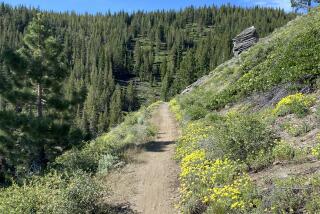American Trips Are a Melting Pot
- Share via
Trek America is offering Americans between the ages of 18 and 38 camping trips with other youths of the same age from different nations.
A 21-year-old company that operates camping tours in the United States, Canada, Alaska and Mexico, Trek America has scheduled trips through the southern United States and Mexico. Tours are limited to 13 people and travel is in a van, which permits flexible scheduling.
The company supplies all camping equipment except sleeping bags. Two people are assigned to each tent, with room for their luggage. Solo travelers are matched with other singles.
Sometimes hotel accommodations are used and are covered in the tour costs, but those that aren’t average $25 per night.
Participants contribute $30 per week toward a kitty that pays for the food. The money goes for most meals, and everyone joins in to cook.
Eleven Trek America tours take from 10 to 46 days. Among them is a 14-day tour that explores the ruins and beaches of the Yucatan for $585 per person. The trips are round trip from Merida, Mexico, with six departures between Nov. 10 and March 15.
An 11-day tour from Miami covers the Florida Keys, New Orleans and Orlando at a cost of $595 per person. There are nine departures between Nov. 13 and March 25.
A 14-day tour from Los Angeles, with stops in San Diego, at the Colorado River, Tucson, the Grand Canyon, Zion National Park, Las Vegas and Death Valley costs $680 per person. There are six departures, between Nov. 17 and March 3.
For more information on Trek America programs, contact Trek America, P.O. Box 1338, Gardena 90249, (213) 323-5775.
Travelers who want to participate in the popular sport of mountain biking can find out about a wide variety of trips in a new 10-page brochure published by America’s largest recreational cycling association, Bikecentennial.
“Get Ready to Go Mountain Biking” provides information on many topics, including where to meet up with other enthusiasts, and lists festivities in many states.
Readers will also find details on winter ski resorts that cater to mountain cyclists during the summer, routes through national forests, mountain bike clubs and associations, plus guidebooks and maintenance manuals.
For a copy of “Get Ready to Go Mountain Biking,” send $2 to Bikecentennial, P.O. Box 8308-P, Missoula, Mont. 59807.
The cool temperatures and clear skies of Nepal offer the most attractive environment for energetic adventurers who want to investigate that intriguing nation, much of which is accessible onlyby foot.
Whether you are going alone or with a group, a detailed guidebook with practical information can be worth the price many times over. “Treking in the Nepal Himalaya,” by Stan Armington ($11.95), is a good choice, and an updated edition is now available.
The book is one of 80 travel-related titles published by Lonely Planet. The series is very popular with budget travelers because the guides have a reputation of being packed with nitty-gritty details on how to get around, where to stay and what to see, plus valuable information on how to side step potential problems, varying from cultural faux pas to safety and medical concerns.
In Armington’s guide, travelers to Nepal are warned about being approached in Katmandu or Hong Kong and being offered money, free air tickets and other incentives to carry goods ranging from gold and drugs to foreign currency. “Forget it,” Armington warns. “Informants are everywhere and the jails in Nepal are dreary.”
Even though you don’t need a guide for a number of the popular trekking routes in the country, Armington advises, a guide can not only make your trip easier, it can also make it cheaper. Trekkers must arrange for food and accommodations at homes along their route, and a knowledgeable guide can negotiate better deals on your behalf.
The 267-page guide also covers route descriptions, equipment, budget accommodations and what would happen if an accident required you to be evacuated by helicopter. The detailed medical and first-aid section was provided by the medical director of the Himalayan Rescue Assn.
A section of the book also focuses on the social and environmental impact of tourism to this area, and what trekkers can do to minimize additional disruptions. A percentage of the income from each Lonely Planet book is now being donated to various ventures, from agricultural projects in Central America to Amnesty International and Greenpeace.
More to Read
Sign up for The Wild
We’ll help you find the best places to hike, bike and run, as well as the perfect silent spots for meditation and yoga.
You may occasionally receive promotional content from the Los Angeles Times.






